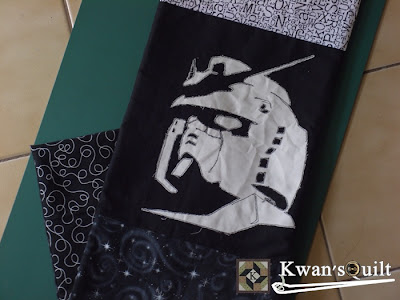Last year I bought 5 yards of American made-PFD cotton fabric from eQuilter for wholecloth painting experiment. At first I thought that it was the same as Kona cotton but it wasn't , this fabric was thinner and stiffer than Kona. So I just left it in storage box. (Almost forgot about it.) Until yesterday I printed my new sized labels. I made them slightly bigger so I can use with bias maker. At first I printed them on white Kona , I ironed fabric to freezer paper and fed to printer. The result was terrible. The fabric was too soft. Then they curled and separated while printing. OK, Not every printer love Kona cotton. I had to clean printer head twice. If I have to print some thing on Kona I will order from Spoonflower. The next, I used American made-PFD with label sticker on the back. (Label sticker is the printable sticker that use for print product label). They were better than I expected. They looked great and the most important point was my printer still perfect fine.
After heat fixed and washing test, they slightly faded. Normally computer- printed fabric may fade after wash as the inks did not penetrate to the back. They just smear on top so they may scrub off while washing. As my craft may not wash often so this way were fine.
Actually I planed to print my labels on Spoonflower, those labels were my print testing swatch. With beyond expectation result, at this time I had 110 labels in hand for small purses and crafts. Anyway I may order quilt labels from Spoonflower when I finish my miniature quilt top. I was not decided that I should print the whole backing or small labels.
Even though I found perfect combination for fabric printing with my printer (Epson ME 340, genuine Epson Ink), I will not print them often as the risk of printer's head broken is so high.
I just share my experience, If you would like to try this way, take your own risk. I am not responsible to your broken printer.
Have a wonderful weekend.
I just share my experience, If you would like to try this way, take your own risk. I am not responsible to your broken printer.
Have a wonderful weekend.




























